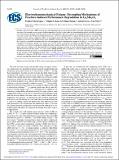| dc.contributor.author | McGrogan, Frank Patrick | |
| dc.contributor.author | Raja, Shilpa N. | |
| dc.contributor.author | Chiang, Yet-Ming | |
| dc.contributor.author | Van Vliet, Krystyn J | |
| dc.date.accessioned | 2020-07-22T13:40:38Z | |
| dc.date.available | 2020-07-22T13:40:38Z | |
| dc.date.issued | 2018-08 | |
| dc.date.submitted | 2018-07 | |
| dc.identifier.issn | 1945-7111 | |
| dc.identifier.uri | https://hdl.handle.net/1721.1/126301 | |
| dc.description.abstract | Decades of Li-ion battery (LIB) research have identified mechanical and chemical culprits that limit operational lifetime of LIB electrodes. For example, severe capacity fade of unmodified LiXMn2O4 electrodes has been linked historically with Mn dissolution and, more recently, fracture of the electrochemically active particles. Mitigation approaches targeting both effects have prolonged cycle and calendar life, but the fundamental mechanistic sequences linking fracture to capacity fade in LiXMn2O4 and many other cathode materials remain ambiguous. Here, we investigate specifically the temporal correlations of fracture, capacity fade, and impedance growth to gain understanding of the interplay between these phenomena and the time scales over which they occur. By conducting controlled excursions into the cubic-tetragonal phase transformation regime of LiXMn2O4, we find that fracture contributes to impedance growth and capacity fade by two distinct mechanisms occurring over different time scales: (1) poorly conducting crack surfaces immediately hinder electronic conduction through the bulk of the electrode, and (2) capacity fades at a faster rate over multiple cycles, due plausibly to dissolution reactions occurring at newly formed electrode-electrolyte interfaces. The deconvolution of these effects in a well-studied cathode material such as LiXMn2O4 facilitates understanding of the complex relationship between mechanics and electrochemistry in LIB electrodes. ©2018 The Author(s). Published by ECS. | en_US |
| dc.description.sponsorship | US DOE Office of Basic Energy Science for the Chemomechanics of Far-From-Equilibrium Interfaces (COFFEI) small group (award no. DE-SC0002633) | en_US |
| dc.description.sponsorship | RSEC Program of the NSF (award no. DMR-1419807) | en_US |
| dc.language.iso | en | |
| dc.publisher | The Electrochemical Society | en_US |
| dc.relation.isversionof | https://dx.doi.org/10.1149/2.0191811JES | en_US |
| dc.rights | Creative Commons Attribution 4.0 International license | en_US |
| dc.rights.uri | https://creativecommons.org/licenses/by/4.0/ | en_US |
| dc.source | Electrochemical Society (ECS) | en_US |
| dc.title | Electrochemomechanical Fatigue: Decoupling Mechanisms of Fracture-Induced Performance Degradation in Li X Mn 2 O 4 | en_US |
| dc.type | Article | en_US |
| dc.identifier.citation | McGrogan, Frank P. et al, "Electrochemomechanical Fatigue: Decoupling Mechanisms of Fracture-Induced Performance Degradation in LiX Mn2 O4." Journal of The Electrochemical Society 165, 11 (August 2018): p. A2458-A2466 doi. 10.1149/2.0191811jes ©2018 Authors | en_US |
| dc.contributor.department | Massachusetts Institute of Technology. Department of Materials Science and Engineering | en_US |
| dc.relation.journal | Journal of The Electrochemical Society | en_US |
| dc.eprint.version | Final published version | en_US |
| dc.type.uri | http://purl.org/eprint/type/JournalArticle | en_US |
| eprint.status | http://purl.org/eprint/status/PeerReviewed | en_US |
| dc.date.updated | 2019-09-17T17:23:39Z | |
| dspace.date.submission | 2019-09-17T17:23:41Z | |
| mit.journal.volume | 165 | en_US |
| mit.journal.issue | 11 | en_US |
| mit.metadata.status | Complete | |
